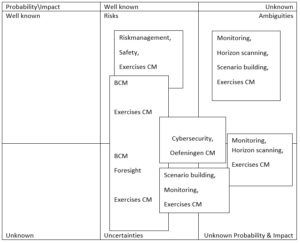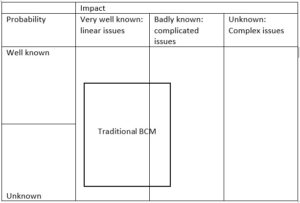Contents
A new approach
Adaptive Business Continuity wants to blow a new wind through the BCM world. To this end, they throw, among other things, the BIA and the risk assessment overboard. When I read the arguments why they do this, it’s not clear why. After all, if I read the authors’ arguments in Appendix B (the manifesto), then there is the following in B.5.1 page 154:
“Adaptive BC discourses a sequential approach. Continuous value, coupled with the core mission of continuous improvements in response and recovery capabilities, leads to the adoption or a non-linear approach that adjusts to ongoing feedback from all participants. … “.
The manifesto
The manifesto in https://www.adaptivebcp.org/manifesto.php also states that things are becoming increasingly complex:
“How long can an organization without a particular service almost always depend on an integrated combination of factors too numerous to identify and too complex to quantify. Moreover, the changes that result from the exact timing and actual impact of a disaster on a service will dictate different judgments about applicable recovery strategies, priorities, and time. Definitive changes to a service’s holistic “ecosystem” cannot be foreknown. ”
Problems become more complex
Nobody can deny that the problems are becoming increasingly complex. However, it can be denied that linear problems no longer occur can be denied. That is why I would like to look back at the picture of the full spectrum of possible disasters. I tried to discuss this in a previous blog, at https://emannuel.eu/risk/relation-bcm-risk-crisis-mngt/ in question 6:

However, when I get the idea of linear issues, difficult or complicated issues and complex issues from the article of https://emannuel.eu/does-history-repeat-itself-or-not/ then I come to the next figure:

Linear approach
I believe that Traditional BCM has a linear approach. This is extremely suitable for linear issues and systems with a (well) known impact and linearisable systems from the complicated part of the spectrum. The question that remains is whether the arguments of the authors are clear enough to put this linear approach aside. This I deny: the objectives of Adaptive BC are not clearly defined enough to throw traditional BCM overboard here. After all, no arguments are given. The BIA simply refers to an article by Rainer Hübert, the authors of which do not reflect the line of thought.
Mutatis mutandis, I think the argument to drop the risk assessment is a non-argument.
After all, they write:
“Administering a proper risk assessment and implementing the resulting action items may necessitate deep knowledge of actuarial tables, information security, insurance and fraud, state and federal regulations, seismological and meteorological data, and the law. Typical continuity practitioners do not possess such deep kn owledge; those who do are most likely specifically trained as risk managers. Adaptive BC practitioners as such should eliminate the risk assessment from their scope of responsibility. ”
A BC Manager does not need to be an expert in all these matters
I do not agree with this: a BC manager does not need to be an expert in all these matters. Rather, he / she must be able to know the right experts within the company, gain their trust, facilitate and coach them in order to achieve results. Then making a risk assessment is not hopeless and not unusable. I leave the criticism of the readers to judge a lot of other claims to the detriment of traditional BCM: it is clear that the authors are trying to declare the traditional BCM dead for reasons they unclearly articulate.
Has the Adaptive BC depreciated for me? No, not at all. Because they offer an answer to issues from a different part of the disaster spectrum: possibly, provided that they have a solid foundation, a solution can be distilled here for complicated and complex systems where I think traditional BCM has a harder time answering as follows:

Conclusion
So in my opinion, the time of traditional BCM is not over as long as there are linear issues. In addition, Adaptive BC will have to develop further into a more mature activity, which can claim its own part of the spectrum of disasters, together with monitoring, building scenarios and future scanning. But next to Traditional BCM. Not instead of.
So there is still work to be done.
